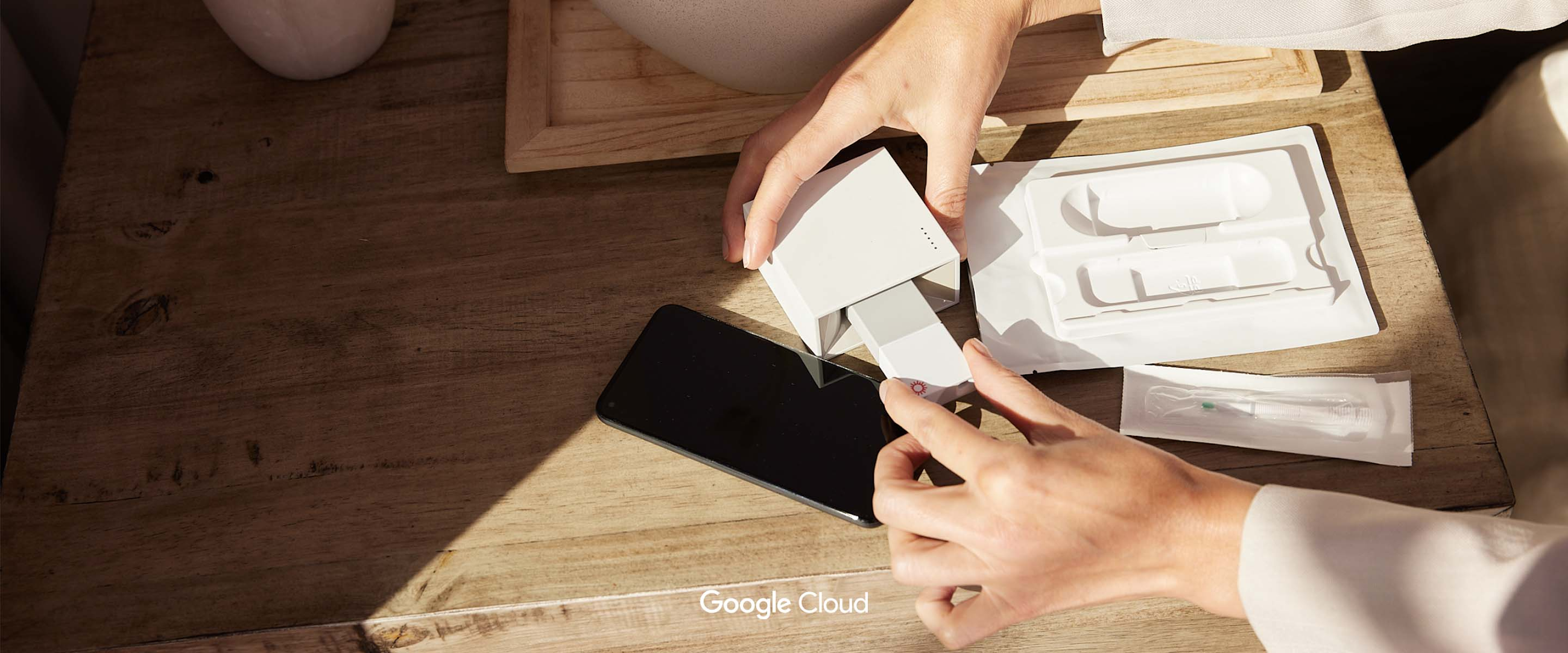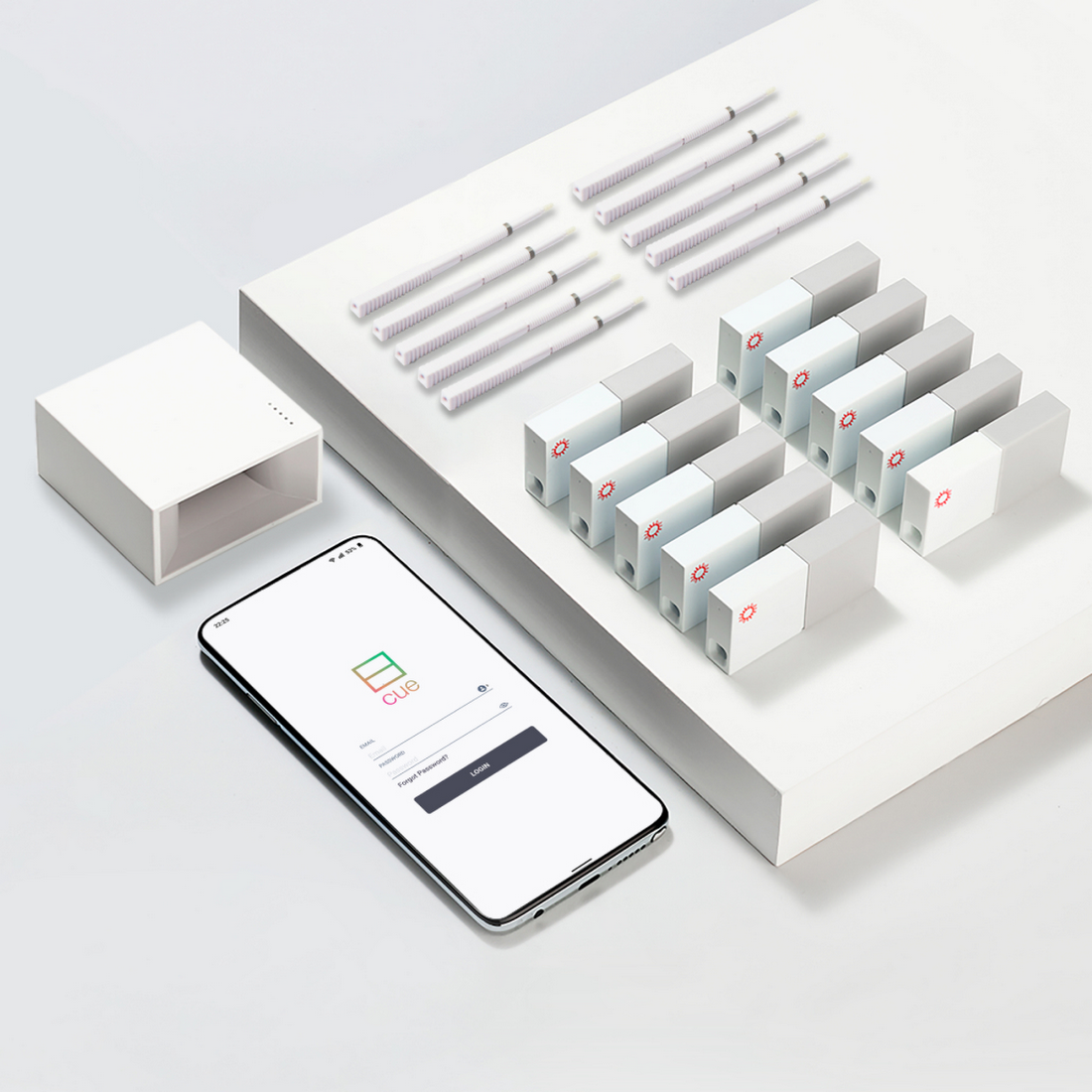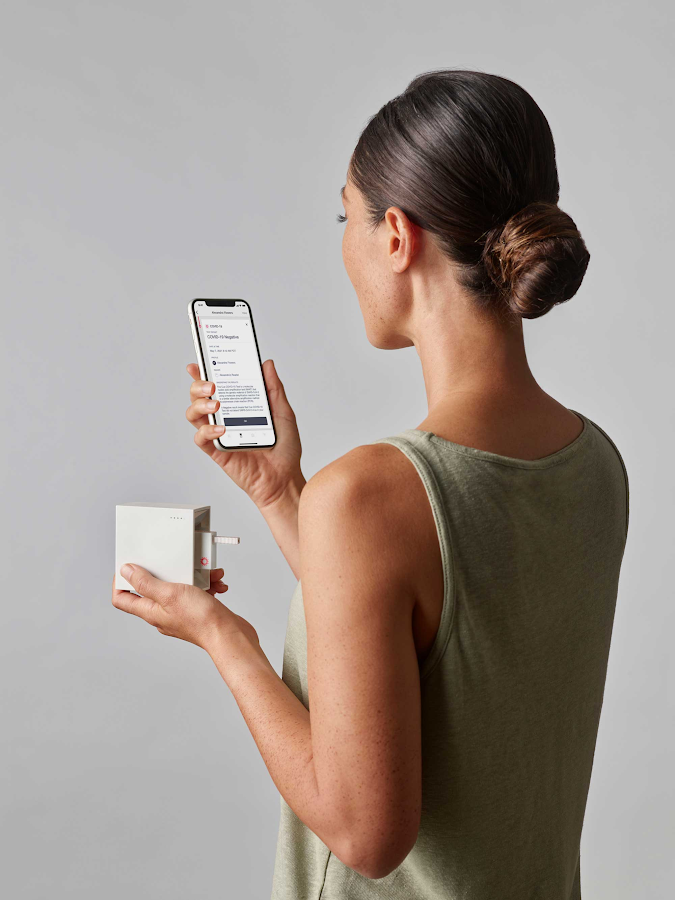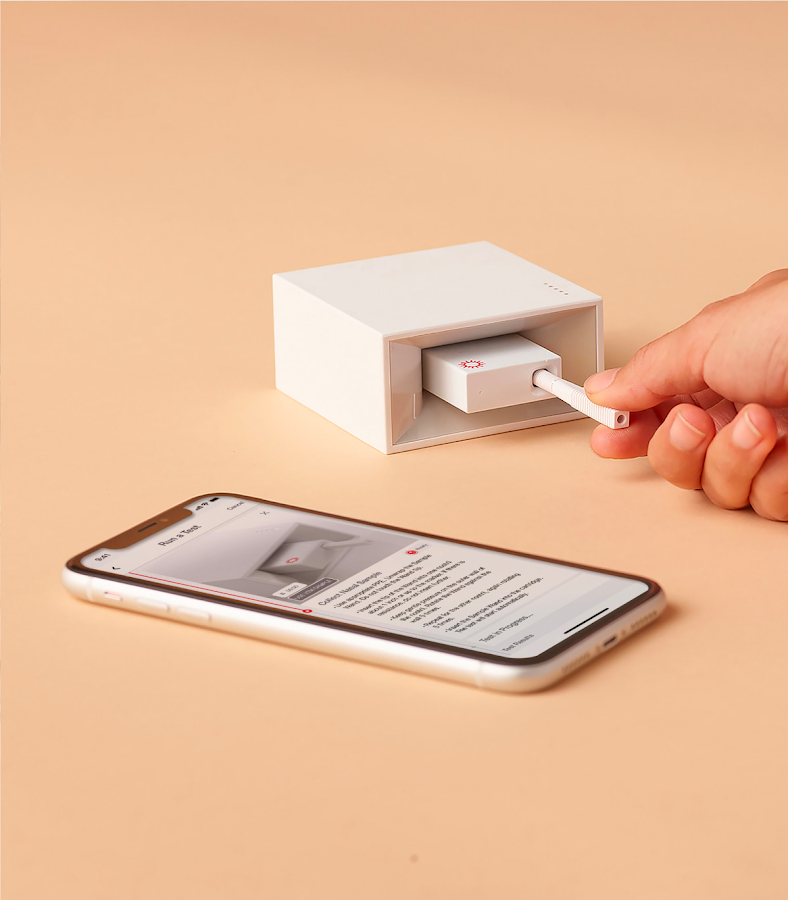A handheld lab: How Cue Health is revolutionizing healthcare diagnostics for COVID and beyond

Alissa Hsu Lynch
Global Lead, MedTech Strategy and Solutions, Google Cloud
A handheld lab: How Cue Health is revolutionizing healthcare diagnostics for COVID-19 and beyond—all from the comfort of home
Editor's note: In response to the COVID-19 pandemic, Cue Health, inventors of the portable Cue Health Monitoring System and Cue COVID-19 At-Home Test, engaged Google Cloud to help quickly transform and scale their back-end operations. The company had largely been in research-and-Development mode since its founding in 2010 and needed to shift to commercial mode, manufacturing and deploying millions of Cue units across the United States, almost overnight.
Cue’s primary goal has been to make simple, remote diagnostic testing more accessible and affordable. Yet an even more important mission was at work, especially during the pandemic: helping public health officials and researchers gain a fuller picture of community health. Cue leveraged Google Cloud’s secure infrastructure to immediately help scale, store, and protect critical data that offered officials a more timely and accurate picture of the COVID-19 pandemic. This data also provides constant feedback to help ensure Cue’s tests continue to be among the most accurate COVID-19 self-test available to users.
This is the story of how they did it.
Modern microbiology began in the 17th century with the discovery of bacteria. Two centuries later, as Louis Pasteur applied the principles of microbiology to explore the relationship between germs and disease, he struggled to trace the cause of rabies—a virus too small to be detected using standard equipment of the day. Through four years of tireless experimentation, however, Pasteur found that a weakened extract of rabies-infected tissue might protect against it. What many consider the first vaccine was born. After this breakthrough, scientists continued to search experimentally for answers until the 1930s, when the invention of electron microscopy allowed them to see and study the contagium vivum fluidum, or virus, so they could develop vaccine improvements.
It’s hard to imagine that conquering COVID-19 might take decades or even centuries, when to a weary public, each additional day of the pandemic seems endless. For modern health warriors to make progress against a virus, they need to do more than see it, identify its properties, and run experiments to find treatments. Collecting and analyzing data is becoming one of the most powerful ways to track the trajectory of a pathogen and to understand which therapies neutralize it most effectively.
Thus far, timely and comprehensive data has proved elusive during the pandemic, helping it rage on for more than two years.
For all the advances made since Pasteur’s time, the reasons for our data being disconnected, even when there is so much of it available, is quite clear: “The majority of the healthcare diagnostics infrastructure we rely on today is built on systems that were established decades ago,” says Chris Achar, chief strategy officer at Cue Health.

Achar describes the traditional diagnostic process: patients make an appointment, visit their healthcare professional, and provide samples that their doctor’s office couriers to a centralized lab. It can take days and even a week for a test result to come back, at which point the doctor informs the patient and recommends a treatment. Diagnostic data is typically centralized with patients having limited to no access.
During the COVID-19 pandemic, time gaps have caused obvious problems for public health officials. The weeks it may take between initial symptoms and final test results became a chasm that left room for mutations to spread before the public even knew they existed. “The average turnaround time for sequencing data in this country is 28 days,” Achar explains. “Delta became the dominant variant within 30 days.”
By the time health officials recognized Delta, it had already taken hold.
As variants like Omicron emerged, people, desperate to stay healthy, scrambled for rapid antigen tests they could take at home. While faster than traditional lab diagnostics, these paper tests aren't as reliable. Moreover, many people don’t report positive results, leaving public health officials blind to the true positivity rate, location, and velocity of spread. Thus, when mutations arise unexpectedly, the tools officials use to counter them rely on mostly outdated information. “It’s resulted in a huge blind spot across the country,” Achar says.
When people fall ill with COVID-like symptoms, they need fast and accurate testing and diagnosis. Likewise, health officials need fast, accurate and connected data reporting so that they can formulate a response in time to make a difference. Unless we cross the data chasm, society will remain at the mercy of every new phase of this pandemic—and of every pandemic that follows.
Pioneering at-home molecular testing
Cue Health has been pioneering technology to provide at-home molecular testing since 2010. The founders, Ayub Khattak and Clint Sever, started the company after observing the H1N1 pandemic, better known as the 2009 Swine Flu outbreak, and the lack of diagnostic capability that existed at the point of care at that time.
“They wanted to create something that was fast, field deployable, reliable, and had the ability to connect data back into the public healthcare system,” Achar says, ”something that could be used by both healthcare professionals and ultimately consumers alike, with a platform capability to do a number of molecular assays.”
The result of their efforts is the Cue Health Monitoring System based on the Cue Reader, a portable, Bluetooth-operated, rechargeable device. The Cue Test Cartridge, a single-use disposable unit that contains all the chemistry and components needed to run a nucleic acid amplification test (NAAT). Lastly, there’s the Cue Health App, a mobile app that can be downloaded and not only allows users to manage their test results but also conduct a supervised test if needed, connect to a doctor via in-app virtual care, and also enables e-prescription capabilities.


Usage is very easy: simply insert a new cartridge into the Cue Reader, collect a sample with a provided wand, and insert into the cartridge. The Cue App does the rest. “The Cue Reader is connected to the mobile app via bluetooth and integrated into e-prescription and healthcare systems,” Achar explains. Cue Health de-identifies test results to analyze near real-time trends, providing valuable insight for public health officials.
Prior to the COVID-19 pandemic, Cue had already been working with the Biomedical Advanced Research Development Authority (BARDA), a division of U.S. Health and Human Services that focuses on advancing healthcare technology. BARDA was interested in Cue’s technology as part of ongoing U.S. healthcare infrastructure with a focus on pandemic response.
Through this relationship, Cue Health was one of the few companies able to access the genome sequence for COVID-19 as soon as it became available in early 2020. Because the Cue Health Monitoring System was designed from the start to be adaptable, Cue Health engineers only needed to change the chemistry inside the cartridges to create a new set that could detect COVID-19. Within three weeks, they had a high-performing test, which would go on to become the first molecular diagnostic product for consumer home use to be authorized by the U.S. Food and Drug Administration.
Validated by an independent clinical study at the Mayo Clinic, the Cue Health COVID-19 test is 97.8% accurate when compared to lab-based PCR.
“People can now run a COVID-19 test anywhere using the Cue Reader,” Achar says, “and have lab-quality molecular test results delivered digitally to their mobile device in about 20 minutes.”
Meeting Pandemic-level Demand
While developing an accurate and reliable COVID-19 test was the most important step, it was only the first one. Demand for this test could extend far beyond a few people or populations in a few geographic regions. Communities and countries across the planet could all benefit from a new kind of test. The next—and far more daunting—hurdle would be to manufacture, distribute, and process the number of tests that fighting a global pandemic requires.
“We looked at a problem that was playing out in society and said there's got to be a better way,” Ayub Khattak, one of the co-founders and CEO of Cue Health says. “We set about bringing together and creating the right technologies that would solve the problem.” With a grant from the U.S. Department of Defense to build Cue Health’s pandemic infrastructure, the company sought help exploring and addressing all the issues they would face in transforming their operations from R&D to commercial scale.
“COVID-19 and swine flu shined a light on a very basic problem of healthcare information access,” Khattak says. “We needed to build a product that scaled.” Cue Health knew they couldn’t scale their on-premises infrastructure fast enough to meet the incredible demand headed their way, particularly given healthcare’s stringent requirements around privacy and security. To realize their vision, Cue Health engaged Google Cloud to help move their existing environment to the cloud. They began with a centralized healthcare data lake capable of storing the vast amounts of test result data that would be necessary to create an accurate picture of the pandemic.




“To earn the confidence of Health and Human Services and the Department of Defense, we had to share our data compliance and approach around security, HIPAA, scalability, and redundancy,” Achar explains. “Google Cloud was great for that, but also internationally, because you have to domicile health data in each of the different territories where you get approved. With Google Cloud, we don’t have to recreate the wheel every time. We’re able to separate data and domicile it within Google Cloud's capability in, say, Canada or Singapore, or wherever we get authorizations."
Cue Health also chose Google Cloud because of its native support for industry-specific data standards such as HL7v2 and FHIR, plus pre-built HIPAA-compliant environments, which made rapid scaling across environments vastly easier. Google Cloud also simplifies secure access for patients and caregivers to time-sensitive data, as well as making that data de-identified with the Google Cloud Healthcare API, so it’s accessible to researchers to perform near real-time analysis of health-related trends.
“It’s the 21st century,” Achar said. “Our health data, something that’s so personal and that’s ours, should be more easily accessible. Google Cloud gave us the scalability we needed, and also the security we needed, because what happens to people’s data and where it gets reported is such an important topic.”
Using Data to Stay Ahead
What’s more, Cue now offers its customers the ability to have their positive COVID sample sequenced through a seperate in-home Cue Sequencing Collection Kit. Once sequenced, genomic data, stored in Google Cloud, can be analyzed at a vast scale using advanced AI and machine learning tools.
“We have this idea that if you can bring in more sequencing information, and if you can connect it to other important data layers, then you can make more meaning out of the information to predict what's going to happen in the future,” Khattak says.


Now that their portable testing solution is publicly available, Cue Health hopes that broad adoption will make lab-quality testing available to communities that don’t have access to diagnostic lab facilities, reduce the time it takes to identify a new variant to 10 days or fewer, and help the medical community determine which populations are at higher risk and which types of individuals respond best to specific types of treatments.
“We’re deployed in a number of underserved communities, rural communities, and even tribal locations,” Achar says. “That's a huge step forward for people who may not otherwise have access to molecular PCR lab-quality testing.”
By crossing the data chasm, public health officials can take precise, preventative action that helps everyone, instead of swinging way too blindly, way too late, for far too many people. “As we’ve announced with Google Cloud, we're building a dashboard that could be used by public health officials,” Achar says. “We envision a mini-mesh sonar network that can show when positivity is increasing in one region as opposed to another, which will help public health officials decide where to deploy more antiviral and surge response teams.”




To scientists who have walked in Pasteur’s footsteps, disease is a complex structure to unravel, a potentially life-altering human condition that demands relief. But studying disease requires more than learning its biological makeup. We must understand how a disease starts and spreads, and how it affects individuals and populations, so we can learn how to stop it. Every month, week, day, or minute sooner that pioneers like Cue Health can deliver crucial diagnostic data to caregivers and scientists, the more they can help an exhausted medical community get ahead of this public health crisis—and stay ahead for the next.
“The implication of having connectivity, data, and being able to take better action not just for the pandemic, but for health in general, is huge,” Achar says. “This is the tip of the iceberg right now.”



